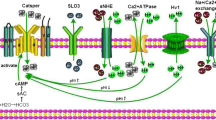Summary
The types of the voltage-dependent calcium channels (VDCCs) in human ejaculatory sperm and the effects of calcium channel blocker (CCB) on human sperm motility parameters in vitro were investigated. The human sperm motility parameters in vitro in response to the pharmacological agents nifedipine (NIF, inhibitor of L-type VDCC) and θ-contoxin (GVIA, inhibitor of N-type VDCC) were compared and analyzed statistically. The results showed that NIF (1, 5, 10 μmol/L) could not only significantly affect human sperm’s shape but also spermatozoa motility after incubated at least 10 min in vitro (P<0.001). GVIA (0.1, 0.5 and 1 μmol/L) could just only significantly affect human sperm’s progressive motility (a %+b %) after incubated for 20 min in vitro (P<0.01), but they both could not significantly affect spermic abnormality rate. It is suggested that L-type VDCC, non L-type VDCCs and isoform of L-type VDCC exist in the cell membrane of human sperm solely or together, and they participate in the spermic physiological processes especially the spermic motility.
Similar content being viewed by others
References
Breitbart H. Intracellular calcium regulation in sperm capacitation and acrosomal reaction. Mol Cell Endocrinol, 2002,187(1–2):139–144
Allamaneni S S, Agarwal A, Rama S et al. Comparative study on density gradients and swim-up preparation techniques utilizing neat and cryopreserved spermatozoa. Asian Androl, 2005,7(1):86–92
Hauser R, Godfrey-Bailey L, Chen Z. Does the potential for selection bias in semen quality studies depend on study design? Experience from a study conducted within an infertility clinic. Hum Reprod, 2005,20(9):2579–2583
Kirkman-Brown J C, Barratt C L, Publicover S J. Nifedipine reveals the existence of two discrete components of the progesterone-induced [Ca2+]i transient in human spermatozoa. Dev Biol, 2003,259(1):71–82
Arikkath J, Campbell K P. Auxiliary subunits: essential components of the voltage-gated calcium channel complex. Curr Opin Neurobiol, 2003,13(3):298–307
Kang M G, Campbell K P. Gamma subunit of voltage-activated calcium channels. Biol Chem, 2003,13(24):21 315–21 318
Catterall W A. Structure and regulation of voltage-gated Ca2+ channels. Annu Rev Cell Dev Biol, 2000,16:521–555
Catterall W A, Striessnig J, Snutch T P et al. Compendium of voltage-gated ion channels: calcium channels. Pharmacol Rev, 2003,55(4):579–581
Koshimizu T A, Van Goor F, Tomic M et al. Characterization of calcium signaling by purinergic receptor-channels expressed in excitable cells. Mol Pharmacol, 2000,58(5):936–981
Darszon A, Wood C D, Beltran C et al. Measuring ion fluxes in sperm. Methods Cell Biol, 2004,74:545–576
Shi Y L, Ma X H. Ion-channels reconstituted into lipid bilayer from human sperm plasma membrane. Mol Reprod Dev, 1998,50(3):354–360
Gonzalez-Martinez M T, Bonilla-Hemandez M A, Guzman-Grenfell A M. Stimulation of voltage-dependent calcium channels during capacitation and by progesterone in human sperm. Arch Biochem Biophys, 2002,408(2):205–210
Bains R, Miles D M, Carson R J, Adeghe J. Hyaluronic acid increases motility/intracellular Ca2+ concentration in human sperm in vitro. Arch Androl, 2001,47(2):119–125
Blackmore P F, Eisoldt S. The neoglycoprotein mannose-bovine serum albumin, but not progesterone, activates T-type calcium channels in human spermatozoa. Mol Hum Reprod, 1999,5(6):498–506
Son W Y, Lee JH, Han C T. Acrosome reaction of human spermatozoa is mainly mediated by alpha1H T-type calcium channels. Mol Hum Reprod, 2000,6(10):893–897
Jagannathan S, Punt E L, Gu Y et al. Identification and localization of T-type voltage-operated calcium channel subunits in human male germ cells. Expression of multiple isoforms. Biol Chem, 2002,277(10):8449–8456
Goodwin L O, Karabinus D S, Pergolizzi R G et al. L-type voltage-dependent calcium channel alpha-1C subunit mRNA is present in ejaculated human spermatozoa. Mol Hum Reprod, 2000,6(2):127–136
Park J Y, Ahn H J, Gu J G et al. Molecular identification of Ca2+ channels in human sperm. Exp Mol Med, 2003,35(4):285–292
Trevino C L, Felix R, Castellano L E et al. Expression and differential cell distribution of low-threshold Ca2+ channels in mammalian male germ cells and sperm. FEBS Lett, 2004,563(1–3):87–92
Author information
Authors and Affiliations
Rights and permissions
About this article
Cite this article
Li, L., Liu, J., Li, J. et al. Pharmacological investigation of voltage-dependent Ca2+ channels in human ejaculatory sperm in vitro . J. Huazhong Univ. Sc. Technol. 26, 607–609 (2006). https://doi.org/10.1007/s11596-006-0534-3
Received:
Issue Date:
DOI: https://doi.org/10.1007/s11596-006-0534-3




